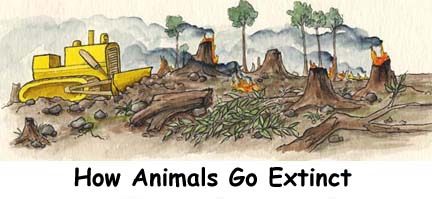

It is a natural part of the living world that some animals adapt better than others to things that happen in their ecosystem. Over time, the more well adapted species will out compete the less well adapted species right out of their niche and into extinction. This process was happening long before humans started playing a role. The evidence is in the fossil record as far back as the dinosaurs.
It is true that there are many examples of human activities causing animals to go extinct. We have done this by over-hunting, development, habitat destruction and careless introduction of predators.
Sometimes this was done on purpose. The Russian army was ordered to kill off the Caspian tiger. They were found across the Middle East and around the south end of the Caspian Sea and across into Asia. The tiger was ordered to be killed by the Russian army to “protect” the people and their livestock and open up the region to development. Once the tigers were gone, farmers cut forests and expanded farms, roads, houses and towns were built.
Perhaps the most famous extinction happened from accidentally with the careless introduction of predators to a protected ecosystem. When sailors first landed on the islands of Mauritius, off the coast of Africa, they found a large flightless bird – the dodo – living there that had never faced predators before. Many dodos were probably killed by sailors, but the biggest toll came from the new predators that arrived with them on their ships. Dogs, cats, pigs, and rats preyed on the dodos, their eggs and young in nests on the ground. They had adapted no skills for surviving predators. It took less than a century for them to disappear from all the islands completely.
Even if the extinction of an animal is blamed on over-hunting, habitat loss is often part of the story. Less than 200 years ago, there were grizzlies that lived out on the American prairie. The Plains grizzly was a fearful sight to early settlers. Yet even these giant animals lost their habitat to the crowds of new settlers coming into the west. They soon disappeared. Now plains grizzlies can only be found in some wild prairies in Northern Canada where few people live to disturb them.
Many species balance on the edge of extinction from habitat loss and may not last another generation. These include some of our favorite animals like the panda, orangutan, tiger, snow leopard and mountain gorillas.
Endangered animals are now studied and protected along with their habitat, in the hopes of their return to safe numbers. Hopefully, knowing the importance of healthy habitats and learning from the experiences with keystone species, we can prevent more animals from going extinct.
________________________________________________________________________________________________
Testing and Assessment
Assess content comprehension about Topics about Endangered Species with the Mutiple Choice Test.
Assess student knowledge of which animals are endangered with the Endangered Animal Labeling Page.
Use the Endangered Animal Coloring Page as a model to reinforce this knowledge.
________________________________________________________________________________________________
